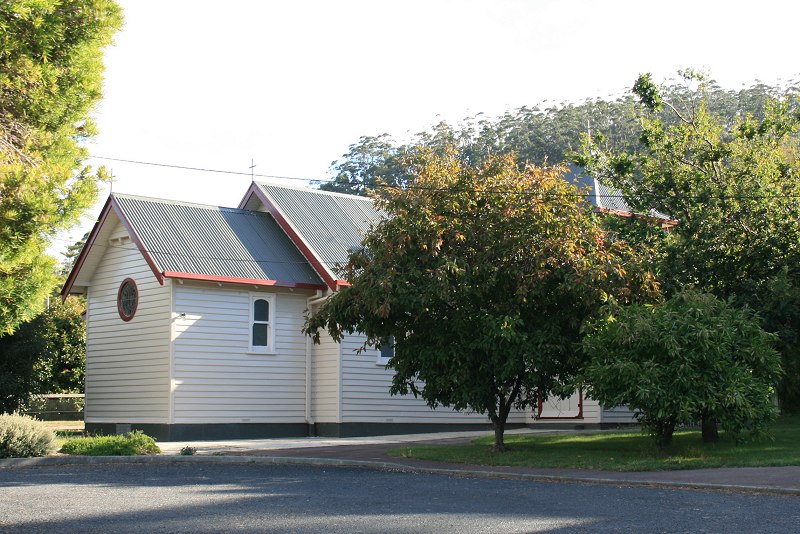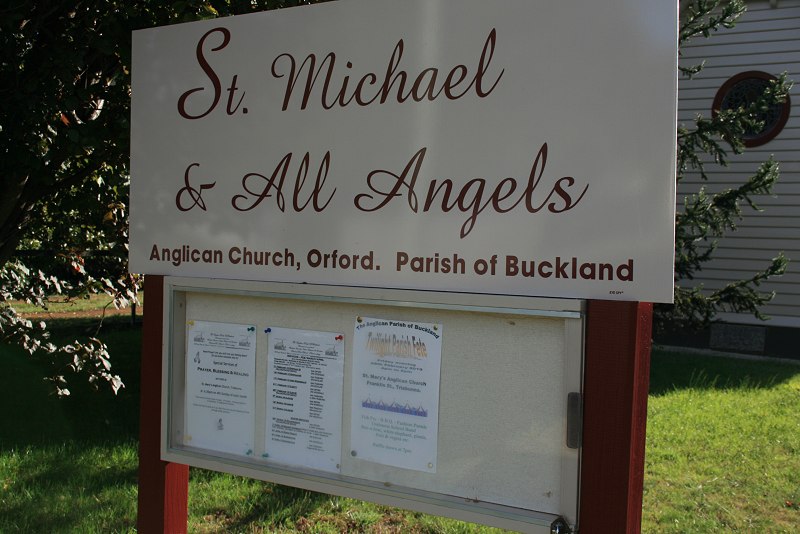30 Charles St, Orford. Google Maps
Opened 1929. Sold 2015
ORFORD’S NEW CHURCH
St. Michael and All Angels
The Foundation Stone Laid
Address by the Dean
As the culmination of many years of quiet effort in the Orford district, a ceremony was carried out in picturesque surroundings on Saturday afternoon by the acting Vicar-General, the Dean of Hobart (Very Rev. A. R. Rivers), to inaugurate a new period for the Orford Church of England, when the foundation stone of the new church of St. Michael and All Angels, which is replacing the tiny but historic building where services have been held, for nearly 60 years, was laid, and consecrated. In spite of the keen wintry air and the damp underfoot from recent rains, there was an enthusiastic and representative gathering: from the district. The stone was laid by Mr. F. Mace, who has for very many years been a keen churchman of Orford, and was lay reader in the absence of a clergyman, the rector of Swansea (Rev. F. C. Best) assisting the dean and the Rev. A. S. Drewett in the service. The warden of Spring Bay (Mr. L. Bresnehan) also was present.
The dean, in his address, spoke of the importance of sentiment in human life, stressing its value as making labour more pleasurable. Without romance, he said, mulch of a man’s work would be very Irksome, and much would not be undertaken at all. The Church and its sentiment stood for a tremendous amount in the lives of the people, and each parish church as it was founded began to make its own history, a history bound up with the intimate details of human life. Children were baptised in it at the commencement of their lives, confirmed within its doors in adolescence, and married at its altar rails. And when they were passed beyond, the last service, too, was carried out in the parish church. It might be the little wooden church of the bushland, with a mere handful of a congregation, or it might be the great stone cathedral of the city, bound up with the lives of thousands, but it was “the same spirit which animated the great and the small. Throughout Tasmania or Australia or Christendom tile churches meant the same to their people. They were carefully looked after and tended with loving hands, and this could not be unless there were some very deep motive behind. The motive was the spirit of love and affection, and the history of the churches might be read within them.
THE CHURCH’S NAME.
In the stone churches of Brittany, when the fishermen put out to the North Sea on their annual voyages, the population of each village would Join with them in prayers for their safety, and when the ships came home-If they came home-the church again was the first thought after three and four months of absence. He felt that the same love and affection would be lavished on the new church of Orford.
In choosing its dedication, they had not selected a name with historical associations, but one rather associated with the mysteries of the heavenly kingdom. The name of St. Michael and All Angels should remind all of the hope of their Christian faith, and help them to come to, everlasting life.
The stone was set in place by Mr. Frederick Mace, who was presented with a silver trowel by Rev. Drewett as a memento of the occasion. Mr. Mace briefly referred to the fact that the stone had come from the local quarries. It was to be the only stone in the foundation, which was of concrete, and had been presented to the church by Mr. J. Griffiths.
Mr. Drewett expressed the thanks of the community to the dean and acting Vicar-General for his visit from Hobart, which must have been made at considerable inconvenience to himself, and his presence was greatly appreciated. It was fitting that Mr. Mace should have been asked to lay the stone, he having been for so long associated with the old church, and it was symbolic of the esteem and affection in which he was held. Parishioners had come from near and far to participate in this ceremony, and there had been much work done to ensure that it should be the success which it undoubtedly was. They were looking forward to another function in a few weeks’ time, when the completed church was to be dedicated, and on that occasion it was hoped that the Bishop (Dr. Hay) would be present.
Afternoon tea was served in the schoolhouse following the ceremony by a committee of ladies, and was much appreciated. The collection over the stone amounted to £42.
[continued below]
[continued from above]
ST. MICHAEL’S ON THE MOUNT.
The tiny wooden building which has served Orford as a church tor so long has had many years of varied history. Long ago it was a timekeeper’s office at the Okehampton quarries, Triabunna, at a time when those quarries were famous throughout Australia, and their stone was used so far abroad as Melbourne. The little building heard for many years the clank of cold chisel, the ring of metal, and the boom of powder in the rocks. Then well over 50 years ago nobody seemed to know exactly how long ago it was–the little shed (for it is not much more) was carried intact to Crabtree’s Quarries, which took the place of those at Okehampton, when the latter were closed. Its second site was some two miles south of Orford, and here it stood for several more years, again as a quarry building. In 1S79 Crabtree’s Quarries, too, were closed down, and In 18S3-46 years ago-the little weather board building was moved again to Orford itself, where it still stands back ¡c amongst the wattles, about 100 yards from the Orford bridge over Prossers River.
Some people of Orford still remember when it was first opened as a place of worship. Before removal from the quarries, services were held there, and the tiny place was packed with people when Rev. Clifford Power first preached. Only on rare occasions now, apparently, has it been so full. However, when it was moved to the wattle groves of Orford itself, where it stands on a rise just back from tho road, Mr. Power called the church St. Michael’s on the Mount, and such it has been for nearly 50 years, its little bell ringing to bid Orford to worship.
THE BELL IN A TREE.
Outside in a gum tree hangs the bell. Once it could be heard for miles away, when ladies in long, flowing dresses, or hoop skirts, flapping draperies, used to hear it as they were driven to church on ,’ Sunday mornings. East Coast farmers, too, with bushy side whiskers, and beards, hymn book in hand, may have heard its cheery tinkle as they brought their families along in buggies and spring carts. But now the tinkle of the bell in the gum tree is not so musical as of old, tor in the wild outburst of joy which the Armistice brought after the Great War, It was cracked, and now the Orford church people are looking about for a new bell to hang in the belfry of their new church.
St. Michael and All Angels is the dedication chosen for the brand new church, whoso framework rises above the neat foundation stone, carrying on the tradition of the Rev. Clifford Power and “St. Michael’s on the Mount.” Amongst the wattle, which are among the glories of Orford, St. Michael and All Angels will stand with its white and orange rose window facing the sea beach and the eastern sun. Pleasingly designed, with nave, chancel, vestry and belfry spire, the weatherboard building will be ready for its dedication in a few more weeks, and Orford will have a church capable of seating a much larger congregation in comfort. Orford is only just becoming known, but is destined to be one of the most popular centres on the East Coast, that “Riviera of Australia,” and the possession of an adequate place of worship will be an added attraction to its beautiful situation.
The old building, which has served its purposes for so long, It was proposed to retain and turn into a hall or schoolroom, but it appears probable now that it will be dismantled by the contractor for the new building (Mr. Walters, of New Town), very shortly by the agreement of the parishioners, and the proceeds of its sale used in the purchase of special furniture for the church. This, however, is yet to be decided.
The Mercury, 29 July 1929


